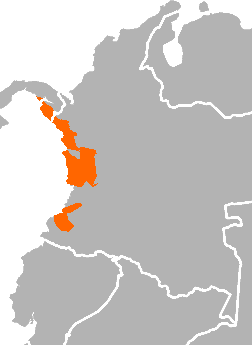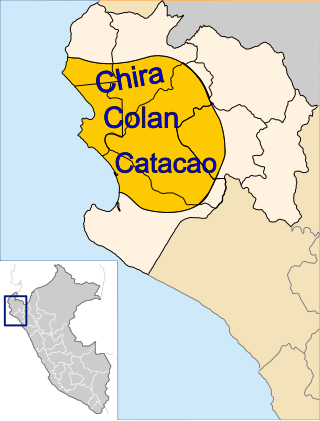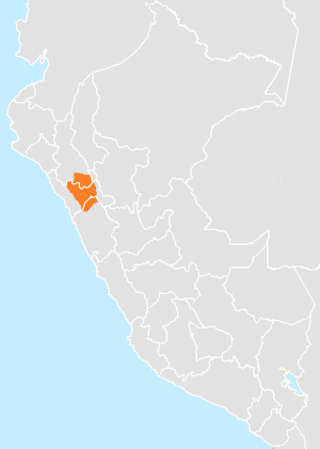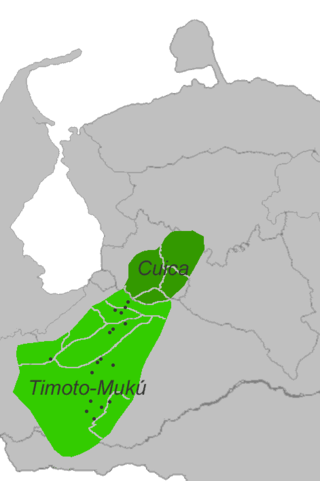Related Research Articles

The Choco languages are a small family of Native American languages spread across Colombia and Panama.

Barbacoan is a language family spoken in Colombia and Ecuador.

Munichi is a recently extinct language which was spoken in the village of Munichis, about 10 miles (16 km) west of Yurimaguas, Loreto Region, Peru. In 1988, there were two mother-tongue speakers, but they had not met since the 1970s. The last known fluent speaker, Victoria Huancho Icahuate, died in the late 1990s. As of 2009 there were several semi-speakers who retained significant lexical, and partial grammatical, knowledge of the language.
The Cahuapanan languages are a language family spoken in the Amazon basin of northern Peru. They include two languages, Chayahuita and Jebero, which are spoken by more than 11,300 people. Chayahuita is spoken by most of that number, but Jebero is almost extinct.
Omurano is an unclassified language from Peru. It is also known as Humurana, Roamaina, Numurana, Umurano, and Mayna. The language was presumed to have become extinct by 1958, but in 2011 a rememberer was found who knew some 20 words in Omurano; he claimed that there were still people who could speak it.

The Catacaoan languages are an extinct family of three languages spoken in the Piura Region of Peru. The three languages in the family are:

Culle, also spelled Culli, Cullí, or Kulyi, is a poorly attested extinct language of the Andean highlands of northern Peru. It is the original language of the highlands of La Libertad Region, the south of the Cajamarca Region (Cajabamba), and the north of the Ancash region. It is known through various word lists collected while the language was still spoken and through vocabulary loaned into the Spanish spoken in the region.
The extinct Hibito–Cholón or Cholónan languages form a proposed language family that links two languages of Peru, Hibito and Cholón, extinct as of 2000. They may also be related to the extinct Culle language, and perhaps to the language of the Chachapoya, but the data for all of these languages is poor.

Sechura–Catacao is a proposed connection between the small Catacaoan language family of Peru and the language isolate Sechura (Sek). The languages are extremely poorly known, but Kaufman (1990) finds the connection convincing, Campbell (2012) persuasive.
Witotoan is a small language family of southwestern Colombia and the neighbouring region of Peru.

The Ramarama languages of Rondônia, Brazil form a branch of the Tupian language family. They are Karo, or Ramarama, with 150 speakers, and the extinct Urumi.
The Puruborá language of Brazil is one of the Tupian languages. It is also known as: Aurã, Cujubim, Burubora, Kuyubi, Migueleno, Miguelenho or Pumbora. Specifically it is spoken in the Brazilian state of Rondônia, in Costa Marques and around the headwaters of the Rio São Miguel tributary of the right bank of the Guaporé. It is nearly extinct, with only two native speakers reported in 2002.
Esmeralda, or Esmeraldeño, is an extinct language isolate formerly spoken in the coastal region of Ecuador, specifically in the western part of Esmeraldas Province. The only existing data for Atacame was collected by J.M. Pallares in 1877.

The Timotean languages were spoken in the Venezuelan Andes around what is now Mérida. It is assumed that they are extinct. However, Timote may survive in the so-far unattested Mutú (Loco) language, as this occupies a mountain village (Mutús) within the old Timote state.
Cañari and Puruhá are two poorly-attested extinct languages of the Marañón River basin in Ecuador that are difficult to classify. Puruhá is scarcely attested, and Cañari is known primarily from placenames. Loukotka (1968) suggests they may have been related instead to Mochica (Yunga) in a family called Chimuan, but Adelaar (2004:397) thinks it is more likely that they were Barbacoan languages.

Otomaco and Taparita are two long-extinct languages of the Venezuelan Llanos.
The Arikem languages of Brazil form a branch of the Tupian language family.
The Yuruna languages of Brazil form a branch of the Tupian language family.
Gayón is an extinct language of western Venezuela, spoken at the sources of the Tocuyo River in the state of Lara. Other than being part of the Jirajaran family, its classification is uncertain due to a lack of data. Coyón is sometimes given as an alternative name (LinguistList), but may simply be an undocumented neighboring language.
Hairúya is an extinct Witotoan language that was spoken on the Tamboryaco River, a tributary of the Putumayo River, in southeastern Colombia.
References
- ↑ Loukotka, Čestmír (1968). Classification of South American Indian languages . Los Angeles: UCLA Latin American Center.
- 1 2 Loukotka, Čestmír. 1949. Sur Quelques Langues Inconnues de l'Amérique du Sud. Lingua Posnaniensis I: 53-82.